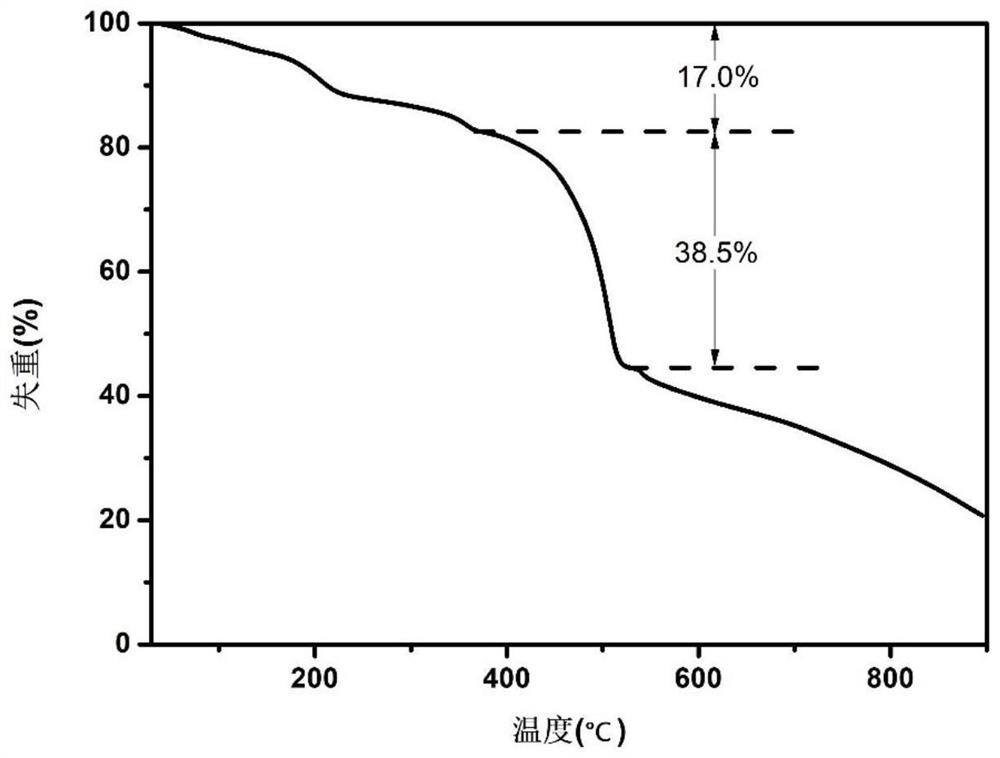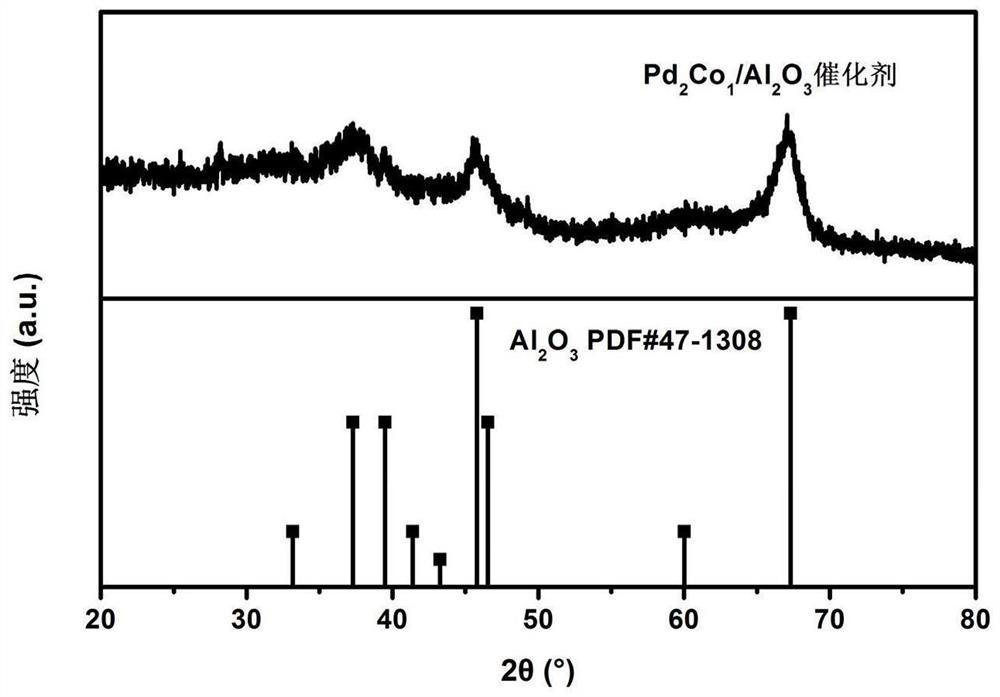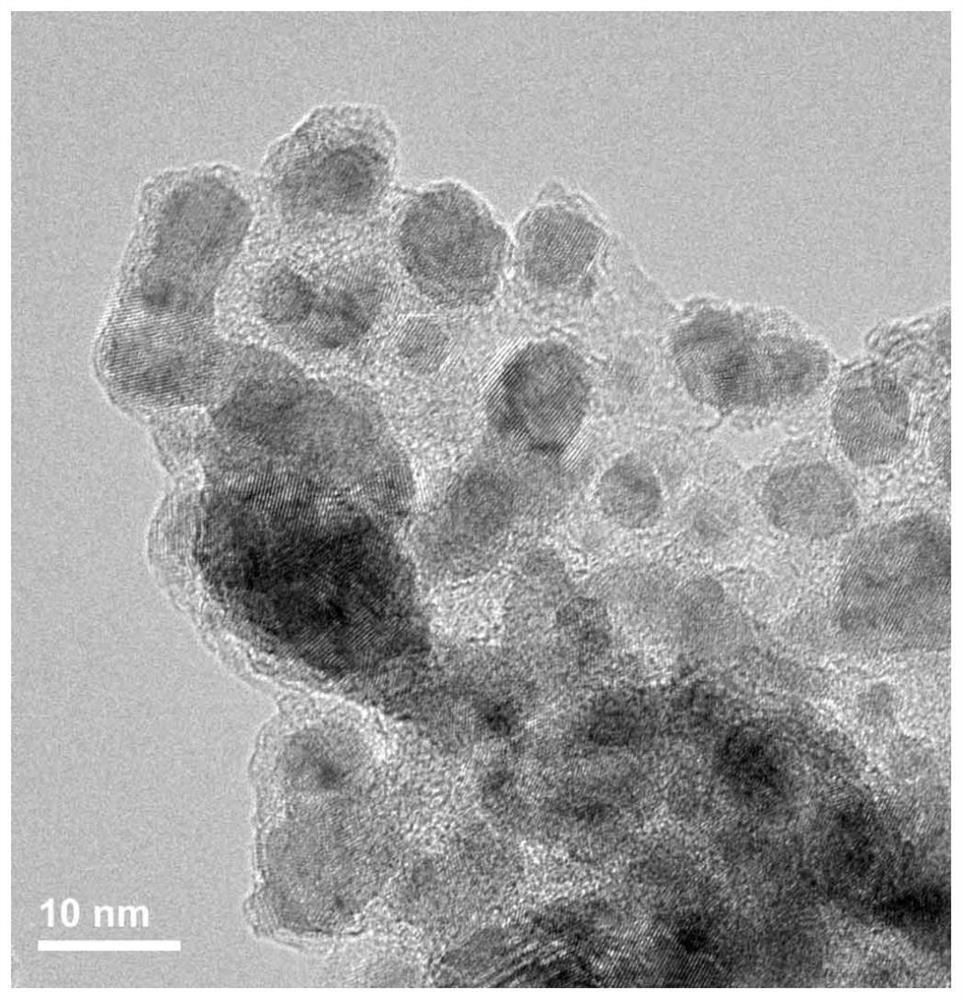Solid acid-bimetallic nanoparticle composite material as well as preparation method and application thereof
A bimetallic nano-composite material technology, which is applied in the field of solid acid-bimetallic nanoparticle composite materials and their preparation, can solve the problems of low reactivity, easy carbon deposition and inactivation, and many by-products, etc., and achieves enhanced interaction, Efficient catalytic conversion and improved dispersibility
- Summary
- Abstract
- Description
- Claims
- Application Information
AI Technical Summary
Problems solved by technology
Method used
Image
Examples
Embodiment 1
[0067] A solid acid-bimetallic nanoparticle composite material, comprising the following steps:
[0068] 1) Preparation of MOF-253 material loaded with Pd-Co bimetallic nanoparticles
[0069] Dissolve 1 mmol aluminum chloride, 1 mmol 2,2'-bipyridine-5,5'-dicarboxylic acid, and 1 mmol glacial acetic acid in 60 mL of N,N-dimethylformamide, and transfer it to the reactor; Then add a certain amount of bisacetonitrile palladium chloride and cobalt nitrate in the reactor, control Pd 2+ / Co 2+ The molar ratio of the precursor is 2:1, while controlling the total metal content in the precursor (Pd 2+ +Co 2+ ) is 1 wt%;
[0070] Pass hydrogen into the reactor again, replace the air in the reactor, react at 80°C for 24h, then raise the temperature to 135°C and continue the reaction for 4h, the obtained solid product is filtered, washed, and vacuum-dried at 150°C for 12h , to obtain the MOF-253 material (ie precursor material) loaded with Pd-Co bimetallic nanoparticles.
[0071] 2) ...
Embodiment 2
[0086] A solid acid-bimetallic nanoparticle composite material, comprising the following steps:
[0087] 1) Preparation of MOF-253 material loaded with Pd-Co bimetallic nanoparticles
[0088] Dissolve 1mmol of aluminum sulfate, 1mmol of 2,2'-bipyridine-5,5'-dicarboxylic acid, and 1mmol of hydrochloric acid in 60mL of N,N-dimethylformamide, and transfer it to the reactor; Add a certain amount of diacetonitrile palladium chloride and cobalt acetate in the reactor to control the Pd 2+ / Co 2+ The molar ratio of the precursor is 2:1, while controlling the total metal content in the precursor (Pd 2+ +Co 2+ ) is 0.25wt%;
[0089] Pass hydrogen into the reactor again, replace the air in the reactor, react at 80°C for 20h, then raise the temperature to 130°C and continue the reaction for 4h, the obtained solid product is filtered, washed, and vacuum-dried at 150°C 12h, the MOF-253 material loaded with Pd-Co bimetallic nanoparticles was obtained.
[0090] 2) Preparation of Pd 2 c...
Embodiment 3
[0094] A solid acid-bimetallic nanoparticle composite material, comprising the following steps:
[0095] 1) Preparation of MOF-253 material loaded with Pd-Co bimetallic nanoparticles
[0096] Dissolve 1 mmol of aluminum chloride, 1 mmol of 2,2'-bipyridine-5,5'-dicarboxylic acid, and 1 mmol of hydrochloric acid in 60 mL of N,N-dimethylformamide, and transfer them to the reactor; then Add a certain amount of palladium nitrate and cobalt chloride to the reactor to control the Pd 2+ / Co 2+ The molar ratio of the precursor is 2:1, while controlling the total metal content in the precursor (Pd 2+ +Co 2+ ) is 2.5wt%;
[0097] Pass hydrogen into the reactor again, replace the air in the reactor, react at 80°C for 36h, then raise the temperature to 140°C and continue the reaction for 5h, the obtained solid product is filtered, washed, and vacuum-dried at 150°C 12h, the MOF-253 material loaded with Pd-Co bimetallic nanoparticles was obtained.
[0098] 2) Preparation of Pd 2 co 1...
PUM
| Property | Measurement | Unit |
|---|---|---|
| particle size | aaaaa | aaaaa |
| particle size | aaaaa | aaaaa |
| particle diameter | aaaaa | aaaaa |
Abstract
Description
Claims
Application Information
 Login to View More
Login to View More - R&D
- Intellectual Property
- Life Sciences
- Materials
- Tech Scout
- Unparalleled Data Quality
- Higher Quality Content
- 60% Fewer Hallucinations
Browse by: Latest US Patents, China's latest patents, Technical Efficacy Thesaurus, Application Domain, Technology Topic, Popular Technical Reports.
© 2025 PatSnap. All rights reserved.Legal|Privacy policy|Modern Slavery Act Transparency Statement|Sitemap|About US| Contact US: help@patsnap.com



